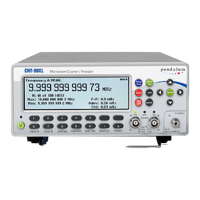Input Signaling Conditioning
Trigger uncertainty due to noise.
Fig. 3-13 shows that less noise still affects the
trigger point by advancing or delaying it, but
it does not cause erroneous counts. This trig-
ger uncertainty is of particular importance
when measuring low frequency signals, since
the signal slew rate (in V/s) is low for LF sig-
nals. To reduce the trigger uncertainty, it is
desirable to cross the hysteresis band as fast
as possible.
Low amplitude delays the trigger point
Fig. 3-14 shows that a high amplitude signal
passes the hysteresis faster than a low ampli-
tude signal. For low frequency measurements
where the trigger uncertainty is of
importance, do not attenuate the signal too
much, and set the sensitivity of the counter
high.
In practice however, trigger errors caused by
erroneous counts (Fig. 3-10 and Fig. 3-12) are
much more important and require just the op-
posite measures to be taken.
To avoid erroneous counting ca
used by spuri-
ous signals, you need to avoid excessive input
signal amplitudes. This is particularly valid
when measuring on high impedance circuitry
and when using 1 M input impedance. Under
these conditions, the cables easily pick up
noise.
External attenuation and the internal 10x
attenuator reduce the signal amplitude, includ-
ing the noise, while the internal sensitivit
y
control in the counter reduces the counter's
sensitivity, including sensitivity to noise. Re-
duce excessive signal amplitudes with the 10x
attenuator, or with an external coaxial
attenuator, or a 10:1 probe.
Setting
For most frequency measurements, the optimal
triggering is obtained by positioning the mean
trigger level at mid amplitude, using either a
narrow or a wide hysteresis band, depending
on the signal characteristics.
Timing error due to slew rate.
When measuring LF sine wave signals with
little noise, you may want to measure with a
high sensitivity (narrow hysteresis band) to re-
duce the trigger uncertainty. Triggering at or
USER MANUAL ● CNT 9x Series ● Rev.22 February 2020

